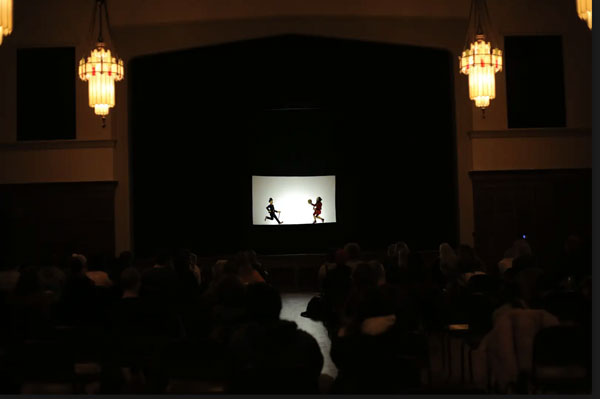By Bruce Chadwick
originally published: 06/05/2023
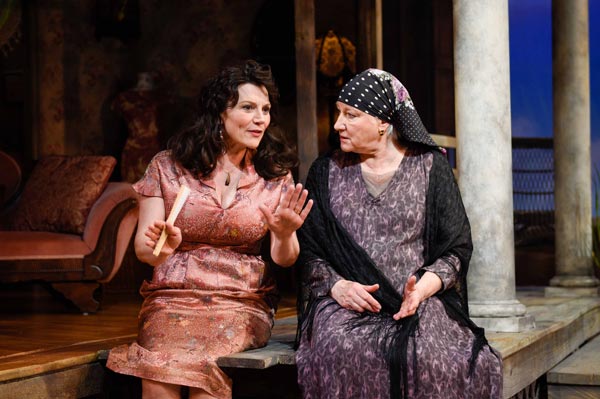
Antoinette LaVecchia and Angella Della Ventura. Photo by Sarah Haley
As Tennessee Williams’ enchanting The Rose Tattoo begins, you are looking at, are part of, a home in a small town on the Gulf Coast, somewhere near New Orleans in the early 1950s, with people running about. The house is an old, ramshackle building with a large porch and a dirt yard – very 1950s Deep South. It is home for a lower middle-class seamstress/dressmaker, the beautiful but troubled Serafina Delle Rose (Antoinette LaVecchia) and her 16 year old daughter, who is growing older very fast. Around them are friends, other teenagers, a priest, women neighbors, the usual gang of small-town folks in the South.
Serafina is in mourning. Her husband of many years, Rosario, has died and in the first fifteen minutes of the play she reminisces about him – romantically and sexually, wondering if she’ll ever meet another man like him. She appears to be forty or so and the chances of that, she thinks, are slim. What to do about her daughter, the target of many boys’ attention? When the play opens, it’s a handsome sailor. What to do about her longtime friends? Neighbors? Her business?
And the new man who suddenly arrives in her life, a handsome but romantically uncertain Alvaro (Anthony Marble).
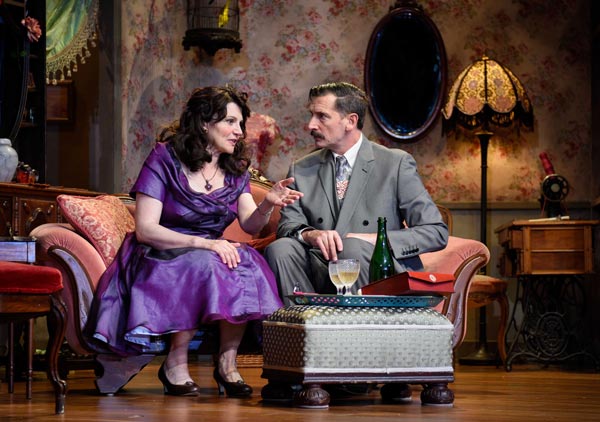
Antoinette LaVecchia and Anthony Marble. Photo by Sarah Haley
All of this is the bottom of the seething volcano of love and exploding emotion that is The Rose Tattoo, a masterful, brilliant Williams play, one of his very best, that just opened at the Shakespeare Theatre of New Jersey, at Drew University. It is majestically directed by Bonnie Monte, the theater’s longtime chief. It is a tremendous work on her part, one of her best directorial works ever.
There are deep mysteries in The Rose Tattoo. How long ago did Serafina’s husband die? Where did Alvaro come from? Why is he there in all this homegrown turmoil at the beginning of the story? Is there something up ahead in the plot that theatergoers need to be watching out for?
The stirring story is as simple as it is complex. The beautiful Serafina is not very interested in men after her husband’s death until the very, very likable Alvaro arrives on the Gulf Coast. She likes him, right way, and he likes her.
She invites him for dinner at her house, which includes a shrine to the Virgin Mary, but only if he sees lights on. Big mystery, right? She then leaves all the lights on. Where is her new man, though? Finally, he arrives, dressed as if going to a party. His arrival to see her opens a hilarious scene in which she is trying to get him to snuggle with her, or not snuggle with her. He does not know what to do and her living room chair, which she keeps pushing backwards to avoid him, is about to crash into a wall. He is perplexed and so is she. What to do? What do at their age?
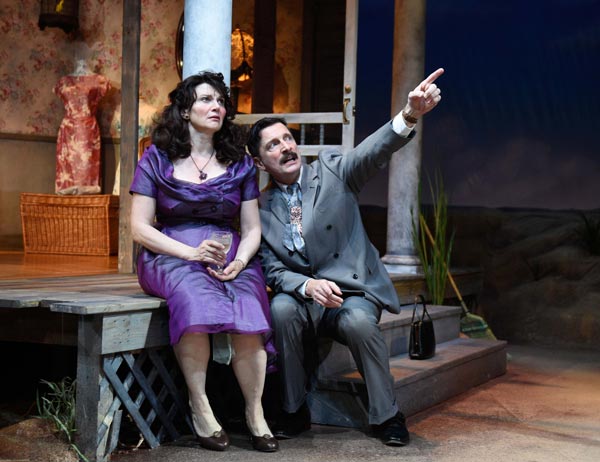
Antoinette LaVecchia and Anthony Marble. Photo by Sarah Haley
The story, in many ways, is the story of all of us, not just two folks who we think, are falling for each other in a small Gulf coast town. My own wife died several years ago. You can pray and talk all you want and get all the advice and counseling that is possible, amateur and professional, but in the end the solution is as simple today as it was in Williams’ early 1950s play – you just move on with your life and hope for the best.
In that sense, this is a universal play. Death happens in all of our lives, and we need to move on. In this mesmerizing Williams play, though, the characters move on slowly, tripping over just about everything as they do. Oh, they get lots of advice from well-intentioned neighbors, an overzealous priest and friends, but in the end they make their own choices and those choices have to collide with the world spinning around them, a very haunting world created by the ever-talented Tennessee Williams.
Will Serafina find new love with Alvaro? Or will everything go wrong? Will Alvaro see all the wonderful things in her that Williams’ sees?
What I enjoyed most about the play was the surreal feeling that something important is going to happen in the story, that rumbles on in a Deep South mist, very soon. What will it be? The whole play is bathed in that gauzy mystery, several gauzy mysteries pulled from the mystical world of Williams. There is something up ahead, isn’t there? Has to be?
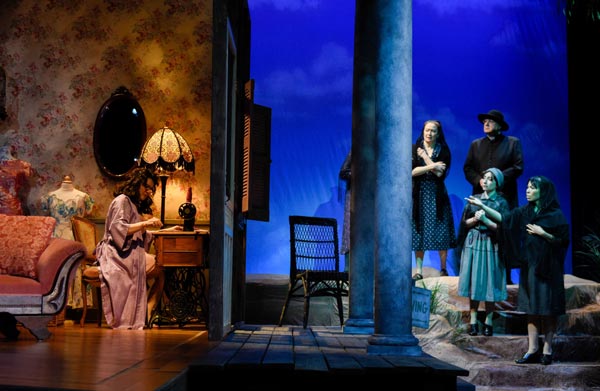
The cast of The Rose Tattoo. Photo by Sarah Haley
The entire cast needs to be applauded for this monumental presentation of one of Williams’ true treasures on stage.
It is the latest production in a long line of productions, and a movie. The first play was staged in 1950 and starred Maureen Stapleton. It went to Broadway in 1951 won six Tony Awards and ran for nearly a year. It became a film in 1955, starring Burt Lancaster and Anna Magnani. It had an Irish opening in 1957 but was promptly shut down on obscenity charges (later overturned in court). The play went to Broadway again in 1966 and came back to New York 1995 and 2019.
Nothing has changed in all these years. This is still a theatrical stunner.
Director Monte gets titanic, marvelous performances from her two leads, the totally lovable Antoinette LaVecchia as Serafina and Anthony Marble as Alvaro Mangiacavallo. They represent two lovers in the 1950s South, but they could be any lovers in any American town in any year. The cast is a large one, sixteen people, and all of them are quite good.
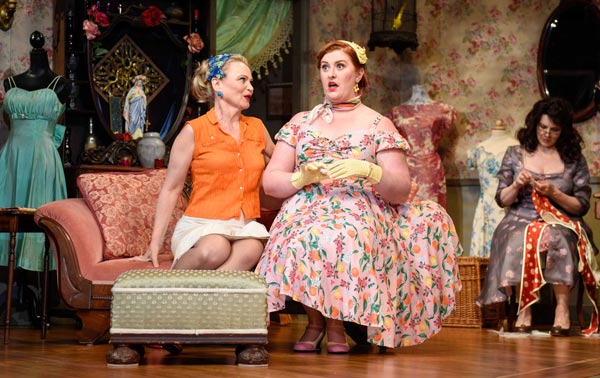
Celia Schaefer and Kayla Ryan Walsh. Photo by Sarah Haley.
The set designer, who built the intriguing house, is Sarah Beth Hall. Costumes are by Hugh Hanson, Lighting by Matt Webb, Sound by Steven Beckel. Antoinette La Vecchia also serves as dialect coach.
See The Rose Tattoo. It is a thunderbolt.
Shakespeare Theatre of New Jersey presents The Rose Tattoo from June 6-18, 2023 in the F.M. Kirby Shakespeare Theatre (36 Madison Avenue in Madison, New Jersey). For more information or to purchase tickets, click here.
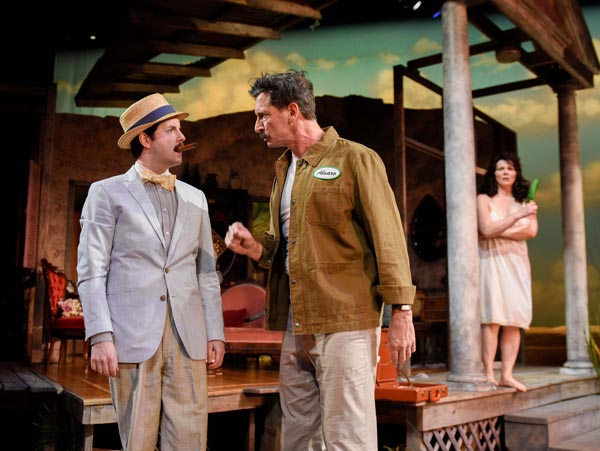
Dino Curia and Anthony Marble. Photo by Sarah Haley
Bruce Chadwick worked for 23 years as an entertainment writer/critic for the New York Daily News. Later, he served as the arts and entertainment critic for the History News Network, a national online weekly magazine. Chadwick holds a Ph. D in History and Cultural Studies from Rutgers University. He has written 31 books on U.S. history and has lectured on history and culture around the world. He is a history professor at New Jersey City University.
FEATURED EVENTS
To narrow results by date range, categories,
or region of New Jersey
click here for our advanced search.
EVENT PREVIEWS















